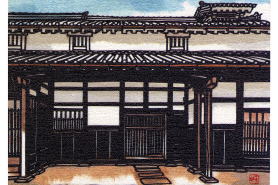

| Jonomonsuji Street - one of the 100 roads of Japan Drum tower of Koshoji Betsuin Temple Koshoji Betsuin Temple took the initiative to newly develop the Jinaimachi town. The temple is often called "Gobo-san" by the local residents. Drum tower used to tell people time of the day like a clock tower. There is a stone monument established beside the drum tower, which commemorates the designation of one of the 100 roads of Japan. |
|
| Former residence of Sugiyama family (right) and Jinaimachi center (left ) The Sugiyama family is an old family, which continued for generations from the foundation of Jinaimachi, and successive heads of the family used name Chozaemon Sugiyama. They administered the town as one of the Hachinin-shu (8 administrators) throughout the Edo era. The old family business is not clear, but after they obtained a brewery license in the 2nd year of the Teikyo era (1685), they succeeded as a brewery. |
|
| Doma or the earth-floored room (Kitchen cum workshops) at former residence
of Sugiyama family Food was cooked using earthen stoves called Kamado located in the earth-floored area. The former residence of Sugiyama family is now open to the public, including the main building,its interiors and gardens. |
|
| An overlook of the historical district Former residence of Sugiyama family The former Sugiyama residence is the oldest merchant’s house among these private houses,with large scale and superior in quality, therefore it was designated as an important cultural property on December 26th, 1983. |
|
| Jonomonsuji Street - one of the 100 roads of Japan The area of Jinaimachi town was designated as an important historical district and heritage site of Japan and the traditional landscape lining the old wooden houses along the stone-paved street is under preservation. |
|
| Intersection at non-right angles Residence of Hashimoto family The roads called "Atemage-no-michi" mean those roads whcih do not intersect at right angles at each cross road in Jinaimachi town. This could make it diffucult for strangers to look throughout the street. These are reminants of devices to avoid being involved in the battles between feudal warlords in the 16th century. |
|
| Yojin-bori (Moat for fire-fighting) (Main) Okutani's residence (this side)and (east) Okutani residence In between the two houses, there is a small moat in 1.5 meters depth for fire-fighting and sewarage purpose and is the small stone bridge called Gan-ei Hashi alongside Jonomonsuji Street. |
|
| Large-scaled entrace hall of former residence of Sugiyama family Former residence of Sugiyama family |
 |
| Landscape of Jonomonsuji Street (South) Okutani's residence and "Atemagenomichi"Jonomonsuji Street designated as one of the 100 roads of Japan |